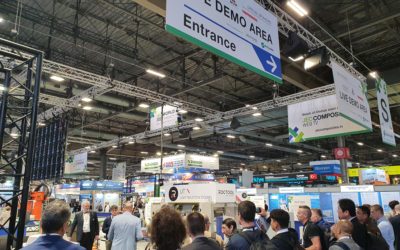FEATURE RECYCLING – JEC MAGAZINE
Recyclable thermoplastic panel for cabin interiors
7 min
• THOMAS POUMADÈRE,, Group Senior Engineer, Aerospace Diab Group
Diab has developed a 100%-recyclable thermoplastic (TP) panel for cabin interiors to meet the challenges of the aerospace market. The thermoplastic panel offers 10% weight savings compared to typical honeycomb and phenolic prepreg panels,
but also 20% lower production costs and at least 70% manufacturing cycle time reduction. It is also fully recyclable and REACH compliant.
Diab is a world leader in sandwich composite solutions, providing the widest range of core materials, kitting and finishings, along with in-depth composites knowledge. Its solutions benefit customers in many markets, including
marine, wind energy, transport, aerospace and industry.
For decades, the company has served the aerospace sector with solutions for applications such as business jet fuselage, radomes, business class seats, trolleys, interior lining, etc. Diab is committed to making its custom-ers’ products more sustainable. It was the
first composite company member of the Science Based Target community and takes concrete action every day to reduce CO emissions.
Although its business consists in providing foam core solutions, the company developed a recyclable thermoplastic panel to actively contribute to sustainable change in the aerospace market and benefit the circular economy.
The Diab foam is at the core of this solution, which meets the challenges aerospace is facing: recyclability, REACH regulation, lower emissions and higher production rates.
This new-generation panel provides a sustainable solution for cabin interiors, where panels combining phenolic resin, glass fibre skins and a honeycomb core have been used for decades. The thermo-plastic panel is already cabin-compliant since
it meets all FST requirements, offering far better skin-to-core adhesion and using stronger thermoplastic skins than equivalent phenolic prepregs.
The panel also has other advantages over phenolic panels, e.g. recyclability, REACH compliance (phenolic resin con-tains carcinogenic/mutagenic components), weight saving, lower production cost and a significantly shorter manufacturing cycle. The
thermoplastic panel can be used floor-to-floor in cabin interiors where sandwich panels are needed: sidewall and ceiling panels, overhead bins, galleys, etc.
The thermoplastic panel
Thermoplastic skins offer many advantages for cabin interior applications, such as very good FST properties, no REACH issues and no porosity generated during assembly. This eliminates the hours generally spent sanding the surface of typical
phenolic interior panels before the finishing can be applied. The thermoplastic skins used for this development were made of a polycarbonate (PC) or polyetherimide (PEI) matrix. Combined with the same typical cabin interior glass fibre fabrics, the TP skins are 7-10% lighter than phenolic resin alternatives.
Such skins used with a Diab Divinycell F (PES) foam core are a perfect match since the closed cells of this PES foam eliminate the need for an edge fill to protect the panel against moisture absorption. The panel also benefits from the foam’s higher
thermal and acoustic insulation properties compared to honeycomb.
The skin-to-core assembly step is significantly faster than with phenolic skins since no curing is needed. The skins are welded directly onto the core without using an adhesive film.
Most manufacturing processes can be used to assemble the panel, but press moulding is the best solution since it provides the greatest cycle time savings and allows more complex shapes. It is also adapted to the production of variable thickness panels as the Divinycell F foam is particularly suitable for crush core
manufacturing process using a molding press.
All the materials selected for this development were already in use in the aerospace sector and qualified by OEMs, making this panel a concrete short-term solution for cab-in interiors.
A cabin-compliant panel
The reference panel used in the development was made of Divinycell F50 foam core (50 kg/m density) and two layers of 7581 glass fibre fabric (300 g/m² dry weight) combined with a polycarbonate matrix for each skin.
This thermoplastic panel is already cabin compliant. It comfortably passes all cabin interior fire requirements: flammability (vertical burn 60s), smoke density, smoke toxicity and heat release (commonly considered the most critical fire test for cabin interiors).
All the fire tests were conducted at the Rescoll test lab (Airbus and Boeing approved). The typical HRRmax within 5 min for a raw PC-skinned panel is 52 kW/m ² (far below the 65 kW/m ² requirement), while the THR2min is lower than 20 kW.min/m ² (for 65 kW.min/m ² requirements).
The PEI-skinned version of the TP panel led to 38 kW/m ² HRRmax and even lower THR2min, confirming the superior fire performance of the PEI matrix.
The panel’s skin-to-core adhesion (peel strength to EN 2243-3) is 30-80% higher (according to the manufacturing parameters used for the TP panel) than the typical adhesion of phenolic prepregs on a honeycomb core. In addition, the mechanical
properties of the TP skins are 10-20% higher on average than phenolic prepregs using similar fabrics.
Fig. 1: 3D-shaped decorated thermoplastic panels manufactured in a single-step process
A single-step manufacturing process
One of the most impressive benefits of this solution lies in the ability to manufacture 3D-shaped decorated thermoplastic panels in a single-step process. During the same press-moulding process, it is actually possible to thermoform the foam core
and the TP skins and to weld the skins onto the core and the decorative laminate onto the skins. This was shown by the various demonstrators at Diab’s stand at JEC World 2022 (Figure 1), produced in collaboration with AviaComp.
This unique process leads to far lower production costs, eliminating many manual operations: lay-up (press shaping), surface preparation (no porosity) and decor application (one-step process). The manufacturing cycle can be reduced by a
minimum of 70%, and even 95% with the most optimised cycle time (lasting only a few minutes when induction heating device from RRooccttooooll was used).
The decorated panels are still FST compliant (HRRmax = 55 kW/m ² during heat release test for a 12.7mm decorated panel), using the Intura 8900 thermoplastic decorative film from AkzoNobel, which is also easier to deform than typical
competing decorative films.
A fully-recyclable panel enabling a circular economy
The new thermoplastic panel provides a solution for the aerospace market to upcycle interiors parts at the end of the cabin’s life. The panel’s sustainability starts with the zero-waste core material – the Divinycell F foam contains reused Diab
production waste. A similar approach is possible with the thermoplastic skins. Diab also demonstrated the recyclability of the whole TP panel, enabling a completely circular economy. Established in collaboration with Rescoll, the panel recycling
scenario began with the mechanical grinding of the whole panel, resulting in a ground mix (Figure 2) made of foam particles (PES), TP skin matrix (PC) and fibres (49% in weight).
The mix was then extruded to produce pellets (Figure 3), which were successfully automatically injection moulded into a closed mould (Figure 4).
This confirmed the promising ability of this thermoplastic panel to be recycled at the end of its cabin interior life.

Fig.2: Ground mix freom thermoplastic interior panels

Fig.3: Extrusion of the ground mix (left) and the resulting pellets (right)

Fig. 4: 2mm-thick dogbone/4mm-thick plate PES/PC parts reinforced with discontinuous glass fibers (49%) and their injeciton moulds
Transfer to serial production
With this development, Diab’s aim was to offer a game-changing solution that benefits the circular economy.
The recyclable thermoplastic panel for cabin interiors is already cabin compliant. All the materials are already used in aerospace and qualified by OEMs. It is therefore a concrete short-term solution to the challenges aerospace is facing. This panel also
offers 10% weight savings, 20% lower production costs, minimum 70% manufacturing cycle time reduction, is 100% recyclable and REACH compliant. In addition, the Divinycell F foam improves the thermal and acoustic insulation
properties of the whole panel compared to honeycomb core. The panel can be manufactured as an already-decorated 3D shape in a single-step process. Due to all these unique features, the panel won both a JEC Innovation Award and the Crystal
Cabin Award at the Aircraft Interiors Expo (AIX) in 2022. The next step (currently in progress) is to support industrial partners in transferring the technology to serial production.
Another aspect will be to duplicate the development using natural fibres, instead of glass fibres, and bio-based recyclable polymers. To be ready for this step, the technical solutions first have to mature and become viable for serial production.
Finally, a recyclable thermoplastic panel similar to the cabin interior panel is currently under development for secondary structural applications in aerospace and nonaerospace applications.



